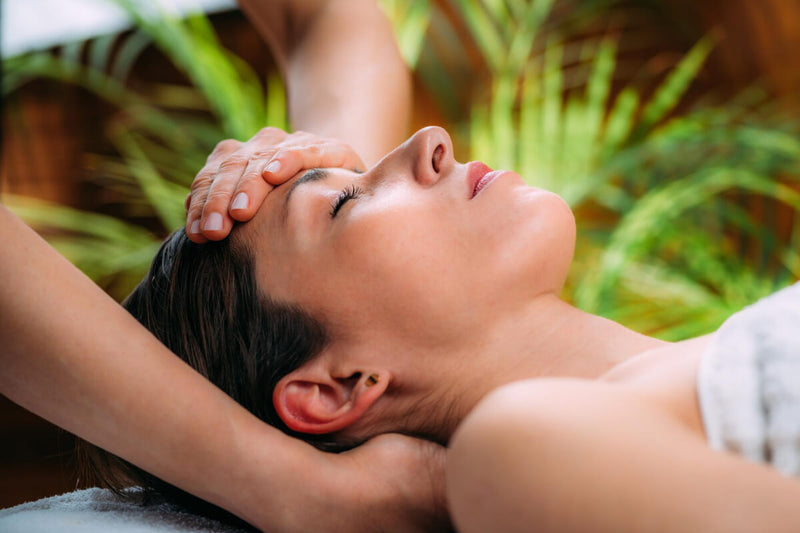Craniosacral therapy is a form of alternative therapy that uses gentle touch to release tension from the body's joints to treat various conditions.
Craniosacral therapy (CST) was developed by Dr. John Upledger, an osteopath, in the 1970s. There are many CST followers and practitioners, typically chiropractors, osteopaths, and massage therapists.
On the other hand, CST has also received criticism, debating its benefits and potential risks because of the limited studies that support CST as a treatment for medical conditions.
In this article, I'll explain exactly what craniosacral therapy is, its uses, risks, and how to do it yourself.

What Is Craniosacral Therapy?
Craniosacral therapy is a natural healing, alternative treatment that uses a gentle touch to release and restore balance in the central nervous system (brain/spinal cord), to promote health, healing, and well-being.
CST uses gentle pressure on specific points along the head, neck, spine, and back to help relieve stress and pain. The CST technique involves using one or more fingers to apply pressure to these areas while moving them around the head and neck.
During treatment sessions, people will have different experiences, including:
- Deep relaxation
-
Feelings of peace and calmness
-
Falling asleep
-
Improved sleep patterns
- Hot and cold sensations
What Is Craniosacral Therapy Good For?
CST can be used as a complementary therapy for any condition where there is muscle tension, stress, anxiety, or pain that originates from compression and/or tension in the head, neck, and back.
CST is most commonly used to treat and offer relief for:
- Headaches and migraines
- Neck pain
- Back pain
-
Stress, anxiety, and depression
-
Fibromyalgia
-
Chronic fatigue syndrome
-
Digestive issues like constipation or irritable bowel syndrome (IBS)
-
Sleep issues and insomnia
- Multiple sclerosis
- Strokes
- Speech impairment
How to Do Craniosacral Therapy on Yourself

Craniosacral therapy should be done under the guidance of a trained practitioner who knows how to use the correct amount of pressure and movement. But you can still learn CST and practice it on yourself at home.
One of the key things to learn is the amount of pressure to use. Practice by putting a coin on your arm. The pressure from the coin's weight pressing down is the maximum pressure that you should be using.
Follow these steps to perform CST on yourself:
- Start with deep breathing to ground yourself. Breathe in through your belly for a count of 6 and exhale for a count of 8.
- Decompress the frontal bones. Bring your fingertips to your forehead and place them on your frontal skull using gentle pressure. Draw them away slowly.
- Relieve headaches and sinus issues through the earlobes. Place your fingertips halfway up the outside of the earlobes and imagine pulling the energy out, without actually pulling on the ears. It's suggested to do this exercise lying down, so your shoulders can stay relaxed.
- Sinus relief through the nose. Place your pinky fingers between your eyebrows and just above the nose, drawing energy away.
Craniosacral Therapy Dangers That You Need to Be Aware of
There are some potential dangers and side effects from craniosacral therapy. The most common side effect after a CST session is mild discomfort, but it's usually temporary and disappears after a day.
Before considering CST, there are some precautions for people with certain conditions:
- People who have epilepsy should not receive CST because it may trigger seizures.
- People who have had a recent head injury, like a concussion, should avoid CST until they've recovered.
- Any other conditions that affect the brain.
- People who have blood clots.
-
People who suffer from heart disease should consult their doctor before receiving CST because it could cause blood clots.
Can You Use Craniosacral Therapy on Babies?

Yes, CST is generally considered safe for babies and children by its practitioners. It can help relax a baby and release tension in the baby's head, neck, and mouth for easier breastfeeding.
CST can be performed on babies for a number of reasons:
- Earaches
- Trouble breastfeeding
- Gastrointestinal conditions and acid reflux
- Constipation
- Birth trauma
- Migraine headaches
-
Sleeping problems
There are also its critics who say that CST can cause harm to infants and children. The American Society says CST should not be used on children under the age of two.
If you are considering using CST for your children, be sure to talk with a pediatrician first. They will let you know if it's safe or not for your children.
Craniosacral Therapy FAQs
Do You Need a License to Practice Craniosacral Therapy?
No, there are no craniosacral therapy certifications or licenses necessary to practice CST. There are no federal or state regulations for the practice of craniosacral therapy. But if the state or locality deems CST as massage therapy, it could fall under the regulations of massage therapy.
Is Craniosacral Therapy Legitimate?
There is much debate surrounding the legitimacy of craniosacral therapy with some calling CST a pseudoscience, while others say it's legitimate. Many of its practitioners and followers say that it can treat a wide range of health conditions. There are limited scientific studies supporting these claims. However, there are many anecdotal reports of success stories.
Is Craniosacral Therapy the Same as Chiropractic?
No, craniosacral therapists don't use chiropractors' methods, but CST can be considered a complementary therapy. Chiropractors are trained doctors who specialize in spinal manipulation. Craniosacral therapists use gentle pressure on the soft tissues and structures that affect the spinal cord.
Sources:
- Cleveland Clinic: https://my.clevelandclinic.org/health/treatments/17677-craniosacral-therapy
- The List: https://www.thelist.com/427936/how-to-do-diy-craniosacral-therapy/
- Healthline: https://www.healthline.com/health/cranial-sacral-therapy
- Pain Science: https://www.painscience.com/articles/craniosacral-therapy.php
- Parent Map: https://www.parentmap.com/article/craniosacral-therapy-for-babies
- Detox Learning Center: https://microbeformulas.com/blogs/microbe-formulas/structural-health-101
